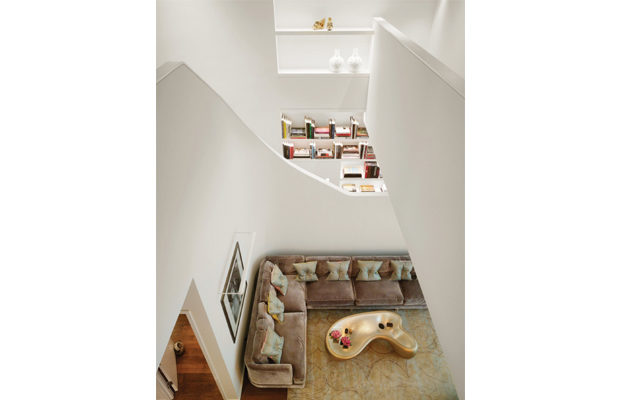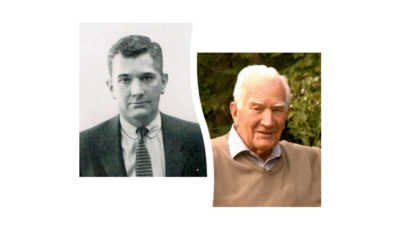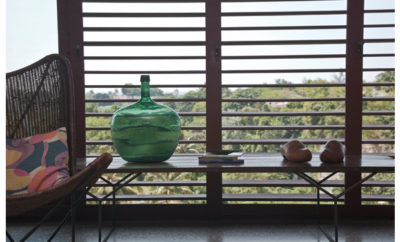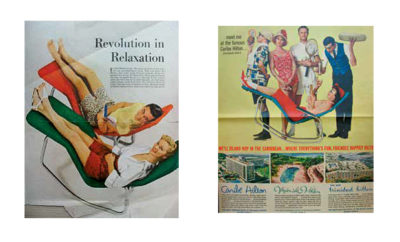
Feature
Design Dream

A dramatic “bird’s-eye” view of the salon focuses on the wraparound sofa custom designed by Francis Sultana and the Whitney coffee table by Mattia Bonetti. The delicately patterned carpet comes from Fort Street Studio.
Francis Sultana has certainly made his mark in London—as a decorator, designer, artistic director, philanthropist, and more. He arrived there from Gozo, a small island in the Maltese archipelago, at age nineteen, took a three-month summer job at David Gill’s gallery, and never left. That was twenty years ago. Along the way, he’s produced his own collections of furniture and accessories, commissioned new work from renowned contemporary designers, and completed interior design projects in London, Tel Aviv, Monte Carlo, and St. Moritz.
For this three-story triplex town house apartment, his first project in New York, Sultana sought to create a showcase for furniture. The clients, longtime art collectors, were relative newcomers in the realm of collecting design, and, longtime Londoners, were also newcomers to life in New York City. “They wanted a home that felt very much like Manhattan,” Sultana says. “They wanted to feel like they were in New York when they were in New York.” The couple loved the feel of the city’s 1930s architecture, but, he notes, they did not want a literal art deco design.
The town house is a perfect showcase for this and more. It is sophisticated and urbane, elegant and yet witty. Sultana loves to use luxurious materials—fur, metals, fine fabrics, exotic skins—in unexpected colors and unanticipated ways, and here his own work is a perfect counterpoint for the equally adroit sensibilities of Mattia Bonetti. “It’s not just about choosing fabrics and the right colors for the walls,” says Sultana. “Creating a real interior is having a complete vision.”
The building itself, 40 Bond Street, is the work of the much-admired Pritzker Prize-winning Swiss architectural firm of Herzog and De Meuron. But if 40 Bond Street has a prestigious address, it’s a mid-block building—urban infill—in the enclave of Manhattan where the neighborhoods Noho and Nolita intersect with Greenwich Village.
For Sultana the space was a dream—three stories and a garden. He turned the basement into “a great big media room” for starters. The ground floor is devoted to the living areas; the double-height salon is divided from the kitchen and dining room with a glass wall by the Swiss-born but New York-based artist Ugo Rondinone, whose studio is just a block away.
The salon features a wraparound sofa that Sultana custom designed for the space. The clients, he said, had asked for “something out of Hollywood” of the golden age of movies. The mink ottoman is from Sultana, too, but other pieces come from Mattia Bonetti, including his Whitney coffee table as well as new chairs that were specially commissioned for this space. Bonetti and Garouste’s almost anthropomorphic Seville torchere works both as light and sculptural object here.
In a similar pairing, the Salome dining table comes from Garouste and Bonetti, while the chairs are another of Sultana’s own designs. Elizabeth Garouste and Mattia Bonetti collaborated from 1980 until 2002. Bonetti now works independently. Other designers represented here include Jasper Morrison, whose fixtures light the kitchen (with stools from Poltrona Frau). Still other pieces (such as the garden table and chairs) are anonymous and from the 1940s. “My role is more as an editor,” Sultana says. A home has to reflect the owner’s personality, and it has to function. You can feel that I’ve been there, but it’s not about me.”
To the garden Sultana added a marble fireplace and a custom-designed marble table-and-bench set along with the 1940s garden furniture to transform the enclosed open space into an outdoor sitting room. “It’s really very special and different from other gardens,” he says. Indeed with its carpet of grass, the elegant minimalist garden seems to be an extension of the dining room; and, indeed, on a warm day the doors slide open to make the two spaces flow as one.
These are good times for Sultana. He recently rejoined the David Gill Galleries—it has two London locations, in St. James’s and in Vauxhall—as artistic director. He has helped commission new collections from Zaha Hadid, Amanda Levete, and Frederick Stelle as well as, of course, Bonetti. The latest of his own furniture collections, called Yana (with pieces inspired by Elsa Schiaparelli, Halston, and Andy Warhol) previewed last spring at the Pavilion of Art and Design in Paris and the full collection will be shown at London’s Frieze Art Fair in October. His first two accessories collections, Mustique and Madison, are also slated for this fall. In addition, a collaborative exhibition and installation done with the Italian fashion house Brioni will make its debut in Brioni’s London store during the design fairs this fall; the exhibition includes work from Fredrikson Stallard, Oriel Harwood, Hadid, and Bonetti.
Ultimately it’s all of a piece— whether it’s interior design, furniture, or curating. “There’s a strong energy behind all of this, “Sultana says. “My goal is creative design that will become historical in the future.”












